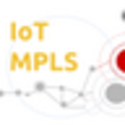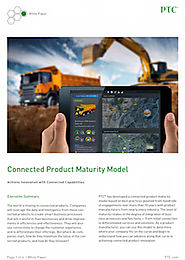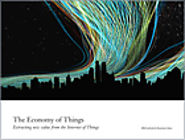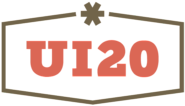-
About
- About Listly
- Community & Support
- Howto
- Chrome Extension
- Bookmarklet
- WordPress Plugin
- Listly Premium
- Privacy
- Terms
- DMCA Copyright
- © 2010-2025 Boomy Labs

 IoT MPLS
IoT MPLS
Listly by IoT MPLS
Freescale brings up the concept of the Internet of Things as a Universal Global Neural Network, with mobile phones as the eyes and ears. IoT Devices, are a class of devices that is just doesn't exist yet as of 2014 when the paper was written. The overall concept encompasses smart machines that are interacting and communicating with other machines, environments, objects, infrastructures in such a way that can make life for human beings better. This encompasses machine to machine communication, machine to infrastructure - which could include telehealth, continuous monitoring, asset tracking, remote security, environmental monitoring and control, as well as industrial build automation. Freescale likens IoT to a tree, with the applications as the leaves, software as the trunk, and technology - meaning sensing, embedded and connectivity as the roots. Smart devices can be broken up to two different categories - 1) Uniquely identifiable devices, those which are heterogenous, used for tracking and control, command, and routing (TCCR). and 2) Those leveraging data insights, behavioral or otherwise. Those leveraging data insights may entail process optimization, resource allocation, context and ultimately and most interestingly, decision optimization using artificial intelligence. This is where machines make decisions, such as with a network of driverless cars that have collision avoidance capability. Freescale breaks the value chain up into a variety of nodes in a chain of connectivity: sensing nodes, connectivity nodes, embedded processing nodes, connection nodes and cloud nodes. At the cloud node, data can be looped back as either application or insights. Most discrete devices, whether category 1 or category 2, only transmit or process a few kb of data per node, unless they involve video/image or audio processing. The pervasiveness of embedded devices is already here, and connecting devices to the web is happening at a slower rate, but these types of functionalities will be pervasive in every aspect of our live within less than a decade.
The Digitization of Everything and Liquid Consumer Expectations are creating the next wave of digital transformation. "Living Services," respond by wrapping around us, constantly learning more about our needs, intents and preferences so they can flex, adapt and make themselves useful. Liquid expectations mean that customer experience is being set by the best of breed across all sectors. Sensors, cloud, connected smart devices and realtime analytics work together to learn and evolve, as if they were fully alive. Services that surprise and delight win out, e.g. physical services that are contextually aware.
[Delaney's note - another term for this could be 'hyper experiential' design elements]
Designers will need to tailor voice, gesture and sensors on body with visual still playing a central role. Design will become more important than ever, taking into account ergonomic, environmental and physical concerns.
We are entering into the third wave of technology - but each wave builds upon the previous. The first wave, Desktop, brought about Google, Amazon, Ebay. The second wave was the rise of mobile, which brought about Twitter as well as many other mobile apps, and has forced many companies to become multi-channel. Over 64% of Americans now own smartphones in 2015. 60% of digital content is mobile, vs. less than 50% in 2013. What is important to note is that each wave denotes deliverability at scale, mass market phenomenons, which changes consumer expectations.
The age we are living in now includes individual companies carving out isolated, "Living Services," experiments, whereas in the future "Living Services," will be widespread with investment in services flowing through devices across all sectors of the economy.
Consumer expectations are being driven by digital natives, who expect life outside of work to be expanded, look for new ways of experiencing things, and place a premium on surprise and delight, much like the first and second wave have delivered. They look for delightful new ways to discover music, friends, fashion, hobbies, etc. In essence, commercial expectations have become liquid - for example consumers no longer compare banks to other banks, they compare banks to design-driven startups such as Uber. Consumers today are attracted to services that leap forward and change industry expectations.
Living Servies know customers as individuals within healthcare, the connected car, and smart cities are expected to pop up knowing individual expectations, at least in East Asia, by 2020. Outside of the consumer space, the maintenance of buildings, equipment, factories and machines will need to have less friction. The Economics of the situation will entail that not investing in living services will result in commercial dissatisfaction, because people who make decisions will chose providers based upon optimization recommendations.
Consumers will make choices based upon the injection of surprise, delight and wonder into every day life - spontaneous recommendations will be necessary. For example , within healthcare - spontaneously recommending a nearby tea house for when visiting an elderly relative.
Initially, Living Services will be consumed for the purposes of getting the most out of downtime. Accenture describes living service examples for homes, jobs, money, cars, shopping, learning, cities and leisure. There is a risk of the concept of Techno-Utopianism creeping into the discussion.
Enabling technologies will include mobile, sensors, network connectivity, cloud, data and analytics. The services must function, live and evolve. Over time as the data needs increase, the use of artificial intelligence and auto-analysis tools will increase. Alternatively, human-assisted living services, such as TrunkClub or Beats will continue to proliferate.
Corporate strucutre will need re-segmentation, as functions may not be able to follow traditional segmentation silos. Priorities must shift to sensing and procedures, with a flexible approach to corporate structure. For example, Nike between 2006 and 2014, developed in-house capabilities for analytics and data visualization. Selling products against long established needs was the business growth model of the 19th and 20th century, emphasizing mass product efficiency. But in the case of living services, often products must be constantly re-designed. This entails the fusion of the CMO and CIO into positions such as the CXO and CDO.
The cellular telephone world's previous outlook on connectivity has been highly smartphone based, which means providing services directly to consumers. Therefore, previous business strategies have been, "B2C," whereas going forward future strategies will include selling off data telephony to industrial and commercial clients, who will in turn sell it to the consumer, meaning that the new wave of business strategies will be more, "B2B2C," focused.
Traditional industries who have not formally sold mobile data, will sell mobile data. Within the Internet of Things, "Enablement of Services," will be the lion's share of the revenue. That being said, the "Service Wrapper," relies on the underlying connectivity.
The cellular telephone provider industry will need to take steps to avoid commoditization, while understanding that new business models, by nature of the direction of technology, will not be as B2C focused anymore. Some strategies that cellular providers may take to avoid commoditization include, "Remote Provisioning," "Building Platforms that include Reporting and Support APIs," as well as "Tamper Proofing and Security Services," and even "Manufacturing Process and Physical Device Management, Including Embedded SIMs."
There is a scale of different types of services that will be offered - with a Y axis representing, "High to Low Data Bandwidth," and the X axis representing "Fixed to Fully Mobile," service segment. Industries can be categorized on this 2D space according to their needs - with logistics being highly mobile but low data, and pharma sensing being limited mobility, low bandwidth, to call out a couple different examples.
Other considerations will be assisting customers with their need to deploy massive numbers of similar devices, which requires a diversified set of capabilities. There is a concerted effort within the cellular provider industry to move beyond the early stages of IoT.

Premise: For the last couple decades, PTC, the maker of SolidWorks, has focused on assisting companies in bringing products to life, principally through 3D Aided Design. Now, as products are increasingly connected, the value-add of PTC changes from simply being able to model products in 3D to being able to model networks. As such, they highlight the Connected Product Maturity Model, which was developed by Adexa, and show where they can add value at each step.
*Level 1 - Unconnected Products *- it's important at this step to understand what's physically possible. This is the domain of traditional product development. This is the stage to start planning - to start understanding what is physically possible in terms of economics, technology and network planning. This level is where one looks at the other stages in the process and starts planning things out.
Level 2 - Get Connected - This involves basic connectivity, enablement, security and middleware. At this stage one may find that new business models start developing - service-focused business model ideas emerge rather than simply selling physical products.
Level 3 - Service - Once products are connected, new potential business models emerge, including service-based solutions, in which issues can be identified and addressed remotely. Providing proactive service, increased uptime and cutting service costs are all ways to increase competitiveness and service to the end customer. At this stage, one may start to develop a suite of tools used to monitor assets, log in remotely, and develop or use APIs and web-based tools to focus on end-user solution value.
Level 4 - Analysis - Run reports, dashboards, query data and feed data into different environments, requiring compliance, finance, quality assurance, product management role visibility on usage statistics, performance and behavior.
Level 5 - Integration - Looking at CRM, ERP, PLM or other database correlations to optimize critical business process & IoT-izing business. This is a way to make IoT data available to ingegrate with other systems, combining complimentary sources and systems to create correlations which extract additional value and eliminate errors.
Level 6 - Innovate - Custom applications for enhancing product utility, presenting data from connected products to end users via portals while equipping people in real-time, as well as rewarding user-feedback. For example, add a feature - if that feature gets used more, improve that feature and acknowledge the feature improvement to usage of the product.
Executive Summary
• The Internet of Everything — the networked connection of people, process, data, and things — is opening up new opportunities (and risks) that public-sector leaders need to consider from multiple perspectives: policy leadership, services provision, and regulation.
• Cisco’s analysis indicates that IoE is poised to generate $4.6 trillion in Value at Stake for the public sector over the next decade (compared with $14.4 trillion for the private sector over the same period).
• The $4.6 trillion in public sector Value at Stake will result from IoE’s ability to help public-sector organizations manage assets, optimize performance, and create new business models.
• 70 percent of the public sector’s IoE Value at Stake will come from agency- specific implementations, while 30 percent will derive from cross-agency adoption of IoE.
• The five primary drivers of IoE Value at Stake for the public sector are:
1) employee productivity, 2) connected militarized defense, 3) cost reduction, 4) citizen experience, and 5) increased revenue.
• More than two-thirds of IoE’s Value at Stake for the public sector (69 percent) will be powered by citizen-centric connections (person-to-person, machine- to-person/person-to-machine).
• $4.6 trillion in public sector Value at Stake is equivalent to about one-third of the expected civilian labor productivity growth over the next 10 years.
• 95 percent of IoE’s total Value at Stake for the public sector will come from just over half (23) of the 40 use cases analyzed by Cisco.
• Cities will generate almost two-thirds (63 percent) of IoE’s overall civilian benefits. To maximize value, cities should combine uses cases rather than approaching them individually.
"We don't even know what it is yet. We don't know what it is. We don't know what it can be, we don't know what it will be, we know that it is cool."

Thanks to the Internet of Things (IoT), physical assets are turning into participants in real-time global digital markets. The countless types of assets around us will become as easily indexed, searched and traded as any online commodity. While some industries will be tougher to transform than others – those with physical limitations, such as manufacturing, will be harder to digitize – untold economic opportunities exist for growth and advancement. Our research shows this will create a new “Economy of Things” with significant consequences.
While industries like newspapers and music have already been completely transformed, the impact on some industries has been much less, and many still retain their essential structure and participants even if the Internet has brought great transparency to the business as a whole. The industries least transformed by the Internet are the ones with the most unstructured or unavailable information.
The IoT is now poised to bring the same real-time information and liquid marketplaces by enabling searching, managing and monetizing assets in the physical world. That won't just mean smart homes that light up when you arrive or washing machines that text you when the cycle is done. The IoT will turn physical assets into participants in real-time global digital markets.
We call this the “liquification of the physical world.” To explore the impact of this transformation, we first look at a historical case of digital industry disruption, then present the findings of macro-economic case studies that we developed in collaboration with Oxford Economics.
This is Part 1 of two parts of our Kickstarter White Paper. You can view the intro here and Part 2 here. Recognizing Your Value Proposition Kickstarter is a value proposition. You are offering people, your "backers," a product or service in exchange for their support.
Creating Software is one of the most creative activities that humans undertake. The main limitation in software is the Human Imagination, and the limits on that are all self imposed. Through the Software Engineering model we see a linear, sequential model of Software Development, something that drastically reduces our ability to create really great software.

Users' expectations of a product depend on the maturity of its market. Markets for software products go through some predictable stages, each with a different emphasis. By identifying what stage your product is in now, you can anticipate some of the pitfalls that lie ahead.
In the post 2008 age, the need for capital is intense. It's important to act now to attract equity capital from the crowd. In order to do this, a proper corporate structure must be adhered to, with a qualified intermediary (counsel). While raising funding from unaccredited investors is not yet legal, waiting based upon SEC rule formation limits access to crowdfunding tomorrow. Some important highlights: 1. Preparing a company today is not illegal, it's public solicitation that's illegal today. 2. An intermediary is required by any business seeking crowdfunding. An intermediary will confirm a business is properly prepared, filed with SEC and an offer is published to prospective qualified investors, along with a complete transaction of security sales. 3. Flexibility can be built in for what isn't known in terms of what will and will not be legal. 4. There will be requests concerning funding and financial health within crowdfunding - this information must be formatted properly. 5. Specific structural elements established must be established prior to crowdfunding to avoid delays. Legal framework, as well as a track record must be in place. 6. Best business practices are a priority - e.g. marketing and setting up a business model that works. In fact, now is the time to build and improve business relationships for when the SEC rules are finalized in the future. One good crowdfunding business practice that has emerged is to establish a community leader position in your company. This allows for proper management of crowdfunding and will be appropriate for your crowdfunding effort.
This article is an easy-to-read perspective on crowdfunding and its, "top 10 myths." The myths and counter-arguments are as follows: 1) It's Online Panhandling - No, actually it's about bringing an idea to life. It's shared enthusiasm for an idea and opportunity to get involved in something new. It's not a fundraiser or charity. 2)
